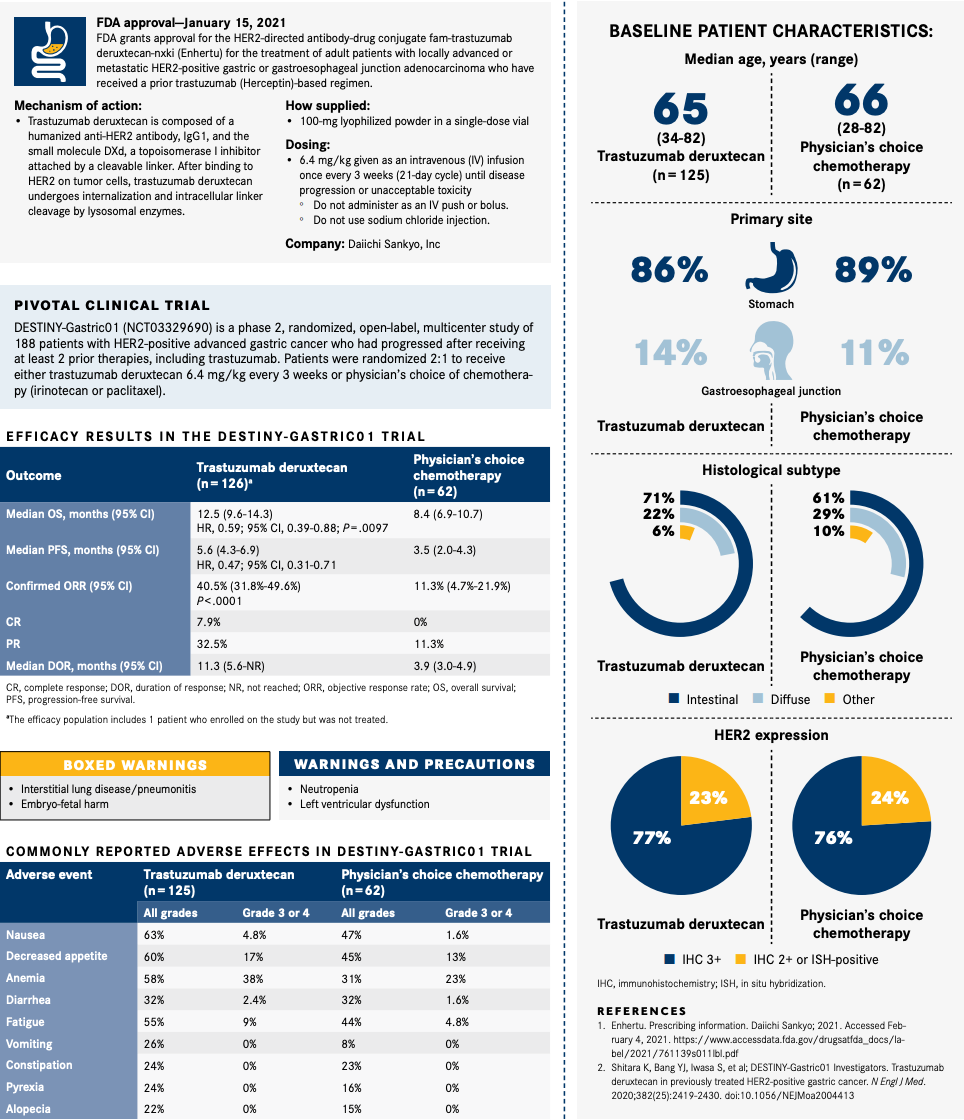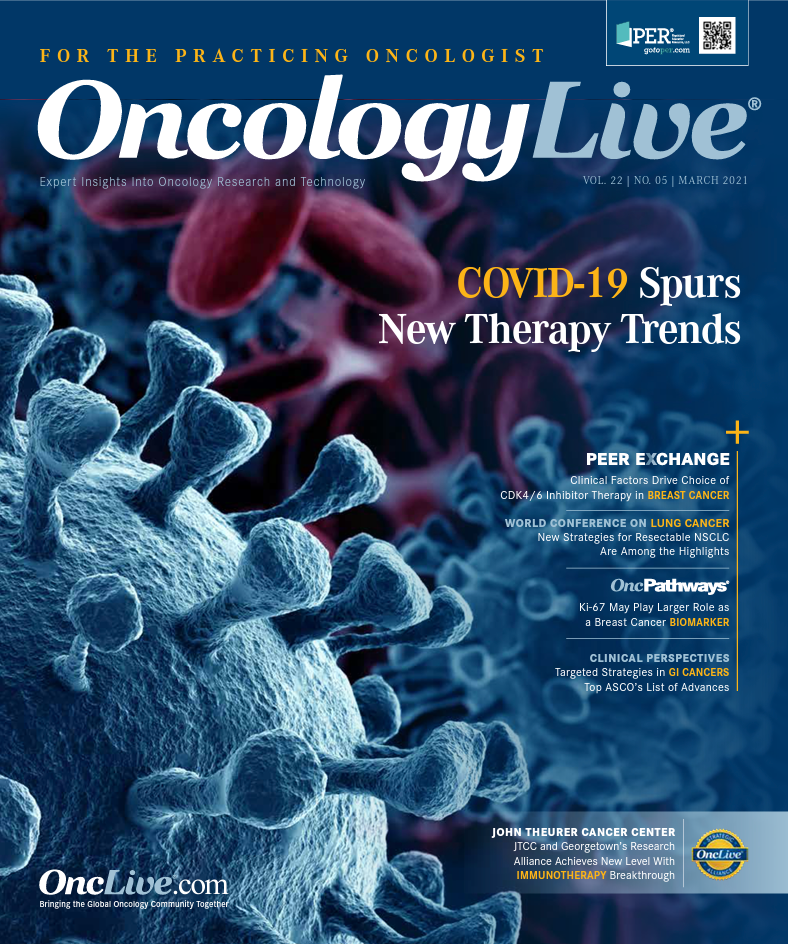Publication
Article
Oncology Live®
Trastuzumab Deruxtecan Enters Treatment Paradigm for Gastrointestinal Cancer Subtypes
Author(s):
Trastuzumab deruxtecan represents a potential new standard of care for adults with locally advanced or metastatic HER2-positive gastric or gastroesophageal junction adenocarcinoma.
Yelena Y. Janjigian, MD

Fam-trastuzumab deruxtecan-nxki (Enhertu) represents a potential new standard of care for adults with locally advanced or metastatic HER2-positive gastric or gastroesophageal junction (GEJ) adenocarcinoma.
The FDA approved the new indication for the HER2-directed antibody-drug conjugate (ADC) on January 15, 2021, for patients who previously received trastuzumab (Herceptin)-based therapy. The agency initially approved the drug in December 2019 for patients with previously treated unresectable or metastatic HER2-positive breast cancer.
The latest indication is based on findings from the phase 2 DESTINY-Gastric01 trial (NCT03329690). The data demonstrated that treatment with trastuzumab deruxtecan resulted in an improvement in median overall survival compared with physician’s choice of irinotecan or paclitaxel, at 12.5 vs 8.4 months, respectively (HR, 0.59; 95% CI, 0.39-0.88; P=.0097).1
The ADC also elicited a higher confirmed objective response rate versus chemotherapy. In the 126 patients who received trastuzumab deruxtecan, the response rate was 40.5% compared with 11.3% in the 62 patients who received chemotherapy (P < .0001).
Notably, the indication includes a boxed warning for embryo-fetal harm and interstitial lung disease (ILD)/pneumonitis. Physicians are advised to look for cough, dyspnea, fever, and other respiratory symptoms.
In an interview with OncLive®, Yelena Y. Janjigian, MD, chief of the Gastrointestinal Medical Oncology Service at Memorial Sloan Kettering Cancer Center in New York, New York, talked about what the approval of trastuzumab deruxtecan means for patients with this disease and the importance of reaffirming the presence of HER2 throughout therapy.

OncLive: What was noteworthy about the patient response to this drug?
Janjigian: In the main cohort of the study, all patients were HER2 positive; the HER2 low-expressing cohort was presented separately. A study in the New England Journal of Medicine2 looked at patients who were HER2 immunohistochemistry [IHC] 3+ or IHC 2+ based on archival samples, not samples taken at the most recent progression. What was remarkable about the study is that, despite having a heavily pretreated patient population in the third-line setting, the overall response is clinically meaningful and has not been previously demonstrated by any HER2- directed agents in later lines of therapy.
Could trastuzumab deruxtecan become the new standard of care in patients with previously treated gastric or GEJ cancers?
It’s important to note that the DESTINY-Gastric01 study focused on patients in later lines—third line or beyond. Despite that, the FDA approved use of trastuzumab deruxtecan after progression of disease on trastuzumab; in other words, potentially in the second-line setting, third line, and beyond. What also is interesting to note is that the FDA label does suggest and encourage biopsies at the time of progression. That’s very important to note because 20% to 30% of tumors lose HER2 overexpression after progression on a trastuzumab-based therapy. Therefore, if you’re going to go after HER2 as a target, it would be important to confirm that it is still present in the tumor.
Studies are underway to evaluate and understand how this drug could be used in the first-line setting and its potential in that setting. Right now in first-line settings, we’re focused on combinations with anti-PD-1–based therapies; regimens [include] pembrolizumab [Keytruda] plus trastuzumab in combination with first-line fluoropyrimidine oxaliplatin–based therapy, which is being explored in the phase 3 setting in the KEYNOTE-811 trial (NCT03615326).
Can you describe the mechanism of action for this drug?
Trastuzumab deruxtecan is an antibody-drug conjugate that uses a trastuzumab-based inhibition with a crosslinking agent and a chemotherapy payload that is quite potent. The cytotoxic ratio to targeted agent ratio is higher than other ADCs that were studied before, such as TDM-1 [ado-trastuzumab emtansine; Kadcyla]. Here, trastuzumab deruxtecan uses 8 chemotherapy payload molecules to a HER2-directed molecule. The agent that’s being used is the topoisomerase inhibitor DM1. It’s really a potent agent, and it is active in gastrointestinal malignancies, particularly in gastric cancer.
In terms of safety, how does trastuzumab deruxtecan compare with existing therapies?
This drug is typically well tolerated. Adverse effects related to cytotoxic chemotherapy, such as decreased white blood cell count and gastrointestinal toxicity, could be seen. One adverse effect that’s important to note and to be aware of is ILD, which is an effect related to HER2 inhibition and HER2 binding in normal epithelial cells and lung interstitial cells. That’s something to be on the lookout for, particularly since in the breast cancer studies and colorectal cancer studies treatment-related deaths were reported from ILD.
In gastric cancer, there were no treatment-related deaths reported thus far, and with close monitoring, dose interruptions, and dose reductions, the patients did well. ILD is something to monitor your patients for, both radiographically and clinically.
What is next in the treatment of HER2-positive gastric cancers?
Trastuzumab deruxtecan has shown efficacy in [this] disease. It’s important to build on that efficacy and continue to try to understand which patients need to continue on HER2 inhibition and which patients need to be changed to other types of therapy because of loss of HER2. I would encourage biopsies in the second-line setting to confirm that the target is present before switching therapy. Use of next-generation sequencing, as well as liquid biopsies or circulating tumor DNA, has helped us understand the heterogeneity of HER2 expression and gastric and esophageal cancer. We need to continue to test our patients for HER2 standard [therapy] in the first-line setting and retest again in second line.










